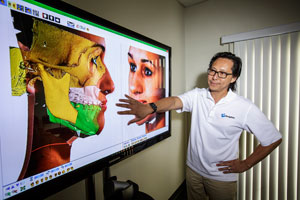Over the past month, Dolphin Imaging and Management Solutions finished upgrades to one of its most popular aquatic-themed software products — Aquarium — as well as enhancements to its mobile app and record-sharing service. But nearly three decades ago, Dolphin was about to close for good. Then employee Chester Wang took a leap of faith and decided to purchase the debt-ridden business, changing his and his company’s fortunes. Now, the Chatsworth firm’s dental software is utilized in approximately 10,000 dental practices and 97 percent of academic orthodontic programs across North America. The company started with a handful of employees, which Wang has grown to about 130 worldwide. “I was employee No. 5 at Dolphin,” he said. “I really fell in love with the business. So when investors said we are looking to sell, I raised my hand and said, ‘How about selling it to me?’” At first, stakeholders didn’t take his offer seriously. But after a few months of searching, they didn’t have any other viable proposals. As a result, they agreed to Wang’s offer with the condition that he personally assume Dolphin’s debt, which was approximately $1 million, and its pending lawsuits from ex-customers and ex-employees. Wang agreed and by the end of 1995, was the proud owner of Dolphin Imaging. “Job No. 1 was to call all our creditors, let them know we had taken over the business and ask them to please give us some time so we could try to work it through,” said Wang. From a strategic standpoint, Wang decided to phase out the hardware part of Dolphin’s product line and to focus on software. His reasoning was that more software was being run on off-the-shelf computers at the time as opposed to specialty devices. Ever since, Dolphin’s focus has revolved around software, but over time, the company has expanded its product portfolio to include the full range of programs needed in a dental office. Virtual modeling Dolphin Imaging started out providing 2-D and 3-D orthodontic images to help dental specialists and patients determine the best treatments and procedures. Over time, the company moved into patient education and practice management software for dental practices. Some of its key products include Dolphin 3-D, software to process 3-D X-rays; Aquarium, interactive patient education software that utilizes 3-D graphics to demonstrate orthodontic procedures and oral surgery; and Dolphin Management, administrative software that helps with billing and office tasks. Dr. Kenneth Brust, who owns his own dental practice in Hesperia, said dental software that is more comprehensive and integrated with functionality is preferred by dentists to help them streamline processes and make it easier to consolidate and access patient data. “When you have a lot more integration with X-rays, insurance and appointments, you are able to combine a lot more things. So when you bring up a patient’s file, you have access to a lot of information that can quickly answer a question or get you to an area where you can see and diagnose.” Aside from orthodontists, the company markets to dental schools and academic programs by visiting campuses, providing product demonstrations and offering special pricing. The incentive behind this strategy is if students learn to practice dentistry using Dolphin technology, they are more likely to purchase its products when starting their own practices, making Dolphin the brand of choice. Thus far, Wang said this approach has proven successful and has helped the company grow. He also said ever since his initial purchase of the company, Dolphin has not had issues with cash flow. Customers make a down payment of up to 50 percent on products that cost anywhere from $5,000 to $35,000. After Wang purchased the company, he settled every legal issue as well as paid off every cent of debt the company owed after about three years. In the meantime, Dolphin created new products and established a reputation among potential acquirers. In 2008, Patterson Dental Supply Inc. of St. Paul, Minn. acquired Dolphin Imaging to utilize its software to help sell 3-D hardware, according to Wang. However, this idea didn’t materialize as planned. Consequently, Dolphin is owned by Patterson but runs almost independently of its parent company. More recently, the company introduced Dolphin 3-D Surgery, a case planning tool that provides a virtual model of the surgery and associated facial changes. Virtual modeling and 3-D imaging are becoming more prevalent in dentistry but Dr. Timothy Chase of New York-based cosmetic dentistry group SmilesNY believes even greater technological advances are on the horizon. “Patients like the fact that we get amazingly clear impressions (from 3-D imaging) without the messy trays and runny material,” he said. “I am sure in the future that 3-D technology will allow us to design the ideal tooth preparation outside of the mouth and a remote drill will do the work for us.” Dolphin Imaging is in the process of developing a Web-based version of its software products, and recently announced it will offer some features this fall for practices that combine orthodontic and pediatric dentistry, a trend in the industry since the recession. Dolphin’s product line gives the company a competitive advantage, as many competitors in the dental industry sell software but none has the same breadth of offerings as Dolphin, Wang said. “I think one of the driving forces behind our success is the culture of the organization,” said Wang. “I am passionate and enjoy working with customers, and my managers and employees feel the same. Even though we are now a subsidiary of a public company, when you deal with Dolphin, you still feel like it is a small, vibrant organization with a family atmosphere.”
